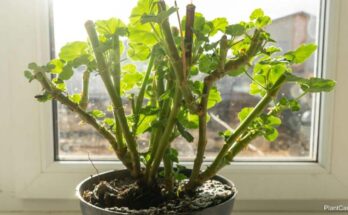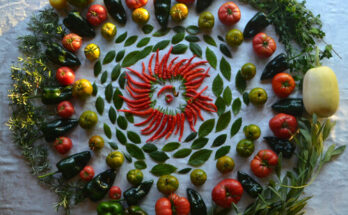Don’t feel too bad if you’ve never heard of gaura (Gaura lindheimeri), as this plant and its genus have a naming problem.
While widely rejected, the plant and its genus were renamed, making this plant’s official name Oenothera lindheimeri.
However, you might have heard of its many nicknames, including:
- Appleblossom grass
- Beeblossom
- Wand flower
- White gaura
There are also many cultivars for this interesting ornamental plant. But gaura makes for an excellent companion plant beyond some fascinating names.
Gaura Companion Plants
Companion planting (AKA complimentary gardening) is mixing plants that have distinct benefits to other plants around them.
This tends to result in much lower maintenance costs, although aesthetics are also frequently a factor.
Key Features Of Gaura
Gaura is a surprisingly hardy plant featuring a basal clump of narrow lanceolate leaves with irregular teeth.
Amidst the leaves are tall stalks, giving the plant a total height of between 20″ and 60” inches, depending on the time of year.
The white flowers emerge from pink buds and have four upwards-facing petals with 8 long, downward-facing stamens.
This gives them the appearance of butterflies or moths flying down the plant, which becomes even more impressive whenever there’s a light breeze to send them dancing.
And this is where the plant also becomes beneficial as well as ornamental.
The flowers attract bees, butterflies, and even some birds.
If pruned after the first blooms fade around midsummer, you can usually get a second round of blooms.
Another good advantage is the deep taproot, which means this drought-hardy plant can be placed beside more demanding plants safely, as long as the soil is well-draining and not too wet.
Being deer-resistant, it can also help protect more susceptible plants.
Thanks to the magic of cultivars, you can get smaller, more compact, or even different bloom colors to fit in with your garden better.
Finally, the plant can be used as a sacrificial plant for Japanese beetles while attracting birds and other natural predators of this pest.
Gaura’s Floral Companions
Several plants work great with gaura, and the following are just a sampling to get you started.
Peony
These popular flowers require almost no maintenance and are a perfect companion for gaura.
The dark green leaves complement the gaura’s medium green to burgundy foliage, while the varied blooms provide a wonderful display.
While peonies like moist soil, their roots are much shallower than gaura, so they help ensure the latter’s taproot doesn’t get too wet.
Phlox
There’s a wide range of options regarding phlox, some of which are excellent groundcovers while others make perfect borders.
Many newer cultivars are mildew-resistant, and the more shallow roots make them a great companion for the deep-rooted gaura.
Even better, phlox have a wide range of colors, and the taller varieties make for nice support for gaura stalks that get a little too top-heavy.
Russian Sage (Salvia Yangii)
Russian sage is one of the best types of sage to pair with ornamental grasses.
The aromatic foliage is pleasant to humans but can help repel many pests.
These wonderful plants produce tall spikes of violet-blue flowers between August and September.
The greyish-green foliage is also an excellent complement to gaura.
For a bit of extra finesse, try the cultivar ‘Blue Spire.’
Ideas For Garden Spaces
While we’ve already mentioned a few great companions, plenty of more out there work best in specific garden themes or functions.
The following are some different places you can use gaura and some plants that compliment gaura nicely in those places.
Borders
If you live in warmer climates, you can mix gaura into perennial borders alongside:
- Artemisia schmidtiana ‘Nana’
- Autumn sage (Salvia greggii)
- Cleveland sage (Salvia clevelandii)
- Geranium ‘Rozanne’
- Grosso lavender (Lavandula intermedia var. Grosso)
- Meadow sage (Salvia sylvestris)
- Mexican bush sage (Salvia leucantha)
- Weigela florida ‘Magical Fantasy’
Floral Gardens
When added to flowering shrubs, aim for broadleaf specimens, which work very well with the thinner gaura leaves.
Some excellent choices include gardenias, hostas, lantanas, and roses.
Mass Plantings
Sometimes you just want to group a bunch of plants together to create a single display.
The variable height of these plants allows for a blend of foliage and flowers and the ability to hide unsightly foundations or make walls more interesting.
- Catmint (Nepata spp.)
- Jupiter’s Beard (Centranthus ruber coccineus)
- Karl Foerster grass
- Rudbeckia
Prairie Themes
When you want to imitate a midwestern prairie (or simply want to fill out a field), gaura makes for a great match with the following:
- Aster
- Black-eyed Susan (Rudbeckia hirta)
- Brown-eyed Susan (Rudbeckia triloba)
- Pink roses
- Purple coneflower (Echinacea purpurea)
- Purpletop vervain (Verbena bonariensis)
- Russian Sage
Additionally, you can choose almost any native or ornamental grass to fill in the gaps.
Source link
Originally posted 2022-08-01 14:11:07.





